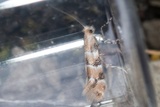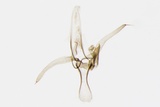Phyllonorycter trifasciella (Haworth, 1828) Species
Last modified: Jan. 31, 2025, 2:36 p.m.
A rather common species throughout Belgium, more common in the northern areas.
Details
- Classification
- Family: Gracillariidae > Subfamily: Lithocolletinae > Genus: Phyllonorycter > Species: Phyllonorycter trifasciella
- Vernacular names
- Oranje kamperfoelievouwmot (NL), Honeysuckle midget (EN), Geißblatt-Faltenminiermotte (DE)
- Synonyms
- Phyllonorycter heydenii (Zeller, 1846)
- First mention in Belgium
- De Fré Ch. 1858. Catalogue des Microlépidoptères de la Belgique. — Annales de la Société entomologique belge 2: 45–162. On page 158 (as L.[ithocolletis] Heydenii. Zell.). view page
- Status
-
Native
Distribution
Imago
Head brown; forewing ground colour brown, whitish pattern consisting of two narrow, transverse bands, two costal and one dorsal narrow striae; all bands and striae heavily edged with dark brown, blackish scales, especially towards the costal area; a patch of blackish scales in the apical area.
Mine
A tentiform mine on the underside of a leaf; many times the leaf margin is spun together diagonally to the main vein into a cone, in other cases the leaf is rolled transversally. The frass is concentrated in a corner of the mine.
See also gracillariidae.net and bladmineerders.be.
Cocoon/pupa
No real cocoon present, just some loose spinning.
Bionomics
Fresh mines are observed in three periods March-April, July-August, and October.
It is not known at which stage the species hibernates. After the emergence of the adult, the pupal skin protrudes through the mine.
Flight periods
The adults fly in three generations a year most common in May–June, less common from the end of July till mid-October, and the least observed in November.
Observed on
- Host plant (species):
- Lonicera periclymenum
The larva lives on Lonicera periclymenum, occasionally also on Symphoricarpos or Leycesteria.



